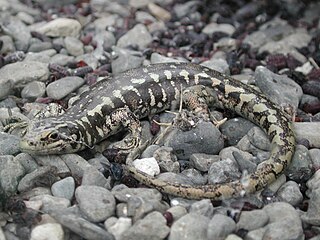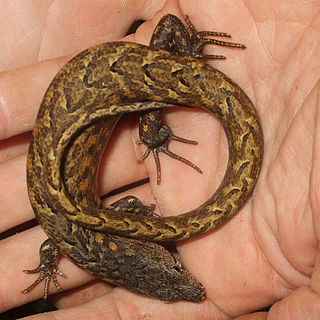
The Otago skink is a rare, endangered species of large skink in the family Scincidae, found in the rocky canyons and grassy patches of Central Otago, New Zealand.

The grand skink is an endangered species of large skink endemic to the central Otago region of New Zealand.

Whitaker's skink, also known commonly as Whitaker's New Zealand skink, is an endangered species of skink, a lizard in the family Scincidae. The species is found only in New Zealand.

Falla's skink, also known commonly as the Three Kings skink, is a species of lizard in the family Scincidae. The species is native to New Zealand.

The chevron skink, is a large species of skink endemic to New Zealand, found only on Great and Little Barrier islands in the Hauraki Gulf. A cryptic forest dweller, it can hide underwater, and is under threat from introduced rats.
The small-scaled skink is a species of skink in the family Scincidae. The first specimen was captured in 1971 on Motutaiko Island, Lake Taupō but it is now known to be endemic to the central North Island of New Zealand in small population pockets. The holotype is in the collection of the Museum of New Zealand Te Papa Tongarewa.
Oligosoma taumakae, the Open Bay Island(s) skink, or Taumaka skink, is a species of skink. It was described from the Open Bay Islands, off the west coast of the South Island of New Zealand.
The slight skink is a skink of the family Scincidae, endemic to the far north of the North Island of New Zealand. The precise distribution is unknown; currently it is only known from localities in the Te Paki region of Northland. It closely resembles the copper skink, Oligosoma aeneum, and was considered to be a member of this species until recently when it was described as a new species using morphological, allozyme and DNA methods. O. levidensum is difficult to distinguish morphologically from O. aeneum, which is probably why it had not been recognised until recently. The main distinguishing feature is the slighter overall body form of O. levidensum compared to O. aeneum. The limbs of O. levidensum are reduced compared to O. aeneum and O. hardyi, the other members of the O. aeneum complex.
The Sinbad skink is a rare species of medium-sized skink endemic to New Zealand where it lives in an alpine habitat in Sinbad Gully, in Fiordland National Park.

The Barrier skink is a species of medium-sized skink, a lizard in the family Scincidae. The species is endemic to New Zealand, where it lives in the alpine habitat of the Darran and Takitimu Mountains of Fiordland. It is one of only two species of New Zealand skinks that live exclusively in the alpine zone, the other being the "Sinbad skink", Oligosoma pikitanga, a closely related species of similar appearance which is found in the same part of the South Island. The Barrier skink was first collected in the 1960s but was overlooked until rediscovery by a pair of mountain climbers in 2005; the species was scientifically described in 2009.

The Te Kakahu skink is a critically endangered species of skink native to New Zealand. When discovered, the entire species was inhabiting a single patch of clifftop vegetation on Chalky Island in Fiordland National Park.

The Burgan skink is a nationally endangered species of skink native to New Zealand. It was described from a specimen found near the Burgan Stream, in the Rock and Pillar Range, Central Otago.

The Eyres skink is a nationally vulnerable species of skink native to New Zealand. It is named in honour of the location of its habitat, the Eyre Mountains.

The cryptic skink is a nationally vulnerable species of skink native to New Zealand.

The Nevis skink is a nationally vulnerable species of skink native to New Zealand. It is named in honour of the location of its habitat, the Nevis valley.

The brown skink is a species of skink native to New Zealand.
The Marlborough spotted skink is a species of skink found in New Zealand.

Gray's ornate skink is a species of skink found in New Zealand.
The Mackenzie skink is a species of skink found in New Zealand.

The Chesterfield or Kapitia skink is a species of skink found in New Zealand. Only discovered in 1994 and for years not recognised as a distinct species, it is endemic to a narrow 1 km strip of coastal vegetation on the West Coast of New Zealand, 15 km north of Hokitika. There are fewer than 200 individuals remaining in the wild. Oligosoma salmo is the only New Zealand skink with a prehensile tail, suggesting it was once arboreal and inhabited coastal forest, which was subsequently cleared for dairy farming. Following the partial destruction of its remaining habitat in 2018 by a cyclone, a small captive breeding population was established at Auckland Zoo.















